Origins
The car that appeared at the 1957 Frankfurt Motor Show was a prototype which in the event differed significantly from the car that entered production the next year, in that it used front wheel drive. In most other respects, notably regarding the two cylinder boxer engine and the overall shape of the car, only minor stylistic changes differentiated the cars that went into production in 1958 from the 1957 prototypes.
The front wheel drive prototype was unstable, however, because of the way the engine was set far ahead of the front axle, and high above the front-wheel drive power train, in what was a relatively light weight car. Setting the engine further back in relation to the front wheels would have involved a level of re-engineering for which neither time nor money were available. The decision was therefore taken to switch to a rear wheel drive configuration. The late decision led to issues with the gear box, however, which could not be redesigned at this stage and was simply switched round to allow for the fact that the drive shaft pointed in the opposite direction to that previously envisaged. For the driver, this gave rise to a back to front gear change, with first and third speed gear level positions nearer the driver and second and fourth positions facing the front of the car.
The late switch to rear wheel drive threatened to reduce luggage space while freeing up space under the bonnet/hood above the low profile boxer engines, [2] and the manufacturer took the opportunity to reposition the spare wheel to a location under the bonnet/hoot in a cradle above the engine.
Goggomobil T 600
Series production of the Goggomobil T600 began on 12 June 1958. The new two door four seater incorporated several then fashionable transatlantic styling features including an eye-catching wrap-around windscreen, small tailfins and a two-tone paint finish. The tail lights followed the approximate silhouette of a small key and were said to resemble those on the stylish Opel Kapitän.
Still at this time considered advanced was the car's monocoque steel bodied construction (without a separate chassis), the rigidity of which was enhanced in 1959 through the addition of reinforcing box section lengths on each side of the floor section. The front wheels were independently sprung and the rear suspension followed the usual pattern of the time, combining a rigid rear axle with leaf springing.
The 584 cc boxer motor developed a maximum power output of 15 kW (20 PS) at 5,000 rpm, which provided for a top speed of 98 km/h (61 mph). The car weighed only about 650 kg (1,433 lb) and was reportedly able to reach an indicated 100 km/h (62 mph) in 61 seconds.
Unusually in an economy car of the period, the T600 incorporated a 12 volt electrical system at a time when the contemporary Volkswagens and German Fords would still come with a 6 volt systems for another ten years. [3]
Name change and range expansion
In order to distance the model from the smaller and more minimalist Goggomobil, and possibly also to try and distract from reliability and structural problems that afflicted early cars, November 1959 saw a name change. The "Goggomobil T600" became the "Glas Isar T600" and the "Goggomobil T700" became the "Glas Isar T700". In the manufacturer's Lower Bavarian homeland, the River Isar is the principal river and would have enjoyed a warm resonance with customers, though subsequently, as the company began to implement an export strategy, it was found that customers in some non-German speaking countries thought the name "Isar" sounded "funny" and cars exported to these markets were branded as the "Glas Isard" which presumably sounded less "funny" . [4] Isard is the vernacular name for a variant of Chamois living in the Pyrénées,known as a fast runner and agile climber, making it a difficult target for hunters. The Glas Isard cars marketed in continental Europe sported a stylized Isard on the sales leaflets and sometimes as an additional badge on the bodywork. [5]
The name change was accompanied by the appearance of a 3-door station wagon variant which was branded as the "Glas Isar K600" or "Glas Isar K700, according to engine size.
Facelift
The only significant facelift was revealed in August 1960. The cars grew an extra 25 mm (1 inch) in length, apparently to accommodate the slightly more prominent rear lights. The option of chrome plated bumpers was added in order to comply with a request made by the US importer. The rear lights were still vertically mounted on the corners of the car underneath little tail fins, but they now became larger and took on a rectangular shape, simpler than hitherto. The rear bumper was reshaped to accommodate the larger lights and the handle for the boot/ trunk lid was repositioned, along with the light that illuminated the rear license plate. The rear roof was reshaped to allow for a much larger rear window which followed contemporary styling trends and expanded the view out.
Buyers of the smaller engined Isar T600 saw the claimed maximum power output reduced from to 15 kW (20 PS) to, 14 kW (19 PS). Curiously the claimed maximum speed of the T600 nevertheless increased to 105 km/h (65 mph). In September 1959 the design of the carburetor had been changed and the supplier switched from Bing to Solex. In 1960, possibly reflecting the increasing minimum octane levels of available fuels, the compression ratio was raised slightly, and the reduction in claimed power also coincided with one of the two changes to the lower gear ratios implemented during the car's life.
There was no significant facelift between 1960 and 1965, but towards the end of the production run, the car acquired a black synthetic leather covering on the dashboard. In the final cars, the Isar's original seats and steering wheel were replaced by those from the newer and slightly larger Glas 1004.

The Audi 80 is a compact executive car produced by the Audi subdivision of the Volkswagen Group across four generations from 1966 to 1996. It shared its platform with the Volkswagen Passat from 1973 to 1986 and was available as a saloon, and station wagon — the latter marketed by Audi as the Avant. The coupé and convertible models were not badged as members of the range, but used a derivative of the same platforms.
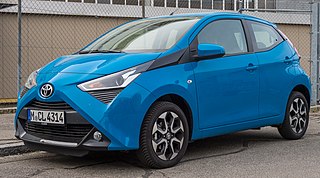
The Toyota Aygo is a city car (A-segment) marketed by Toyota mainly in the European market between 2005 and 2022 across two generations. The Aygo was first displayed at the 2005 Geneva International Motor Show. It was built alongside the related Citroën C1 and Peugeot 107/108 at the Toyota Peugeot Citroën Automobile Czech (TPCA) joint venture in Kolín, Czech Republic. The Aygo's production ended in 2021 and the model was replaced by the crossover-styled Aygo X.
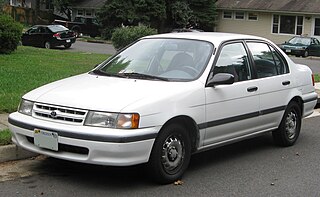
The Toyota Tercel is a subcompact car manufactured by Toyota from 1978 until 1999 across five generations, in five body configurations sized between the Corolla and the Starlet. Manufactured at the Takaoka plant in Toyota City, Japan, and sharing its platform with the Cynos and the Starlet, the Tercel was marketed variously as the Toyota Corolla II — sold at Toyota Japanese dealerships called Toyota Corolla Stores — and was replaced by the Platz in 1999. It was also known as the Toyota Corsa and sold at Toyopet Store locations. Starting with the second generation, the Tercel dealership network was changed to Vista Store, as its badge engineered sibling, the Corolla II, was exclusive to Corolla Store locations.

Hans Glas GmbH is a former German automotive company, which was based in Dingolfing. Originally a maker of farm machinery, Glas evolved first into a producer of motor scooters, then automobiles. It was purchased by BMW in 1966, mainly to gain access to Glas's patents; they were the first to use a timing belt with an overhead camshaft in an automotive application. Its limited model range was shortly phased out by its new parent.

Goggomobil was a series of microcars produced by Hans Glas in the Bavarian town of Dingolfing between 1955 and 1969.

The Audi Coupé was a liftback coupé version of the Audi 80, first shown in 1980. The bodywork was shared with the Audi Quattro. The second generation Coupé arrived in late 1988 and was based on the B3 Audi 80, albeit with a different suspension. The Coupé remained in production until the end of 1996 and spawned the Audi S2 series of sports versions. A convertible model arrived in 1991, called simply the Cabriolet, and remained in production until 2000.
The Staunau was a German automobile manufactured from 1950 until 1951.

F103 is the internal designation for a series of car models produced by Auto Union GmbH in West Germany from 1965 to 1972, derived from the earlier DKW F102. To signify the change from a two-stroke to four-stroke engine, the DKW marque was dropped in favour of Audi, a name that had been dormant since before the Second World War.

The Goliath 1100 and later the Hansa 1100 is a small automobile that was manufactured from 1957 until 1961 by the Bremen based Goliath-Werke Borgward & Co, a subsidiary of Borgward. A two-door saloon and a three-door kombi (estate) version were available from launch and a two-door coupe was introduced a year later. For 1959, the Goliath name was discontinued and the car was rebadged as the Hansa 1100, recalling Borgward’s prewar model of the same name.

The Daihatsu Storia is a subcompact car which was produced by the Japanese automaker Daihatsu between 1998 and 2004. It effectively replaced the similar sized Charade, which was produced alongside it for a year. It was also sold as the Toyota Duet in Japan, which replaced the Corolla II. In international markets, with the exception of a few countries, the Storia was sold as the first-generation Daihatsu Sirion.

The Glas 1700 is a middle class four door saloon produced by Hans Glas GmbH at Dingolfing. The prototype was first presented in September 1963 at the Frankfurt Motor Show. Later versions of the coupé and cabriolet bodied Glas GT were also powered, in some cases, by the same engine as the saloon. The saloon was produced between August 1964 and December 1967, but the manufacturer never had the investment capital sufficiently to expand production capability and the model was discontinued after the by now badly indebted manufacturer was acquired by BMW.
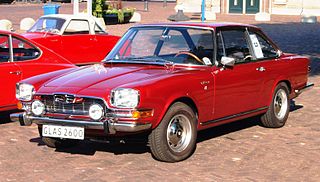
The Glas V8 is a V8-engined coupé produced by Hans Glas GmbH at Dingolfing. The car was first presented in September 1965 at the Frankfurt Motor Show, where it became nicknamed the "Glaserati" because of its Frua design, which shared many themes with contemporary Maseratis.

The Glas GT is a sports coupé produced by Hans Glas GmbH at Dingolfing. The car was first presented as the Glas 1300 GT in September 1963 at the Frankfurt Motor Show, with volume production starting in March 1964. The much rarer cabriolet version appeared in May 1965 and a larger engined 1700 GT in May 1965.
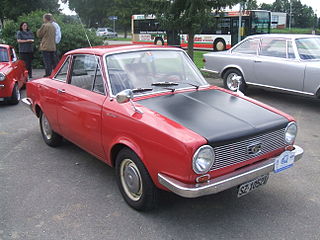
The Glas 1004 is a small two-door, four-seater automobile produced by Hans Glas GmbH at Dingolfing. It was first exhibited in public, in coupé form, at the Frankfurt Motor Show in September 1961. Volume production of the 1004 coupé started in May 1962, and in January 1963 saloon/sedan and cabriolet versions joined the range along with the more powerful Glas 1204. September 1965 saw a yet more powerful variant, the Glas 1304. In September 1966, a fastback Kombilimousine (estate) was added. The 04s were produced at least until December 1967, and new cars were listed for sale through much of 1968.
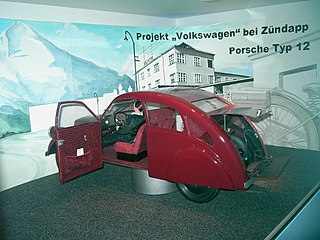
The Porsche Type 12 was a German project to develop an "Everyman's automobile" for Zündapp. Fritz Neumeyer, then owner of Zündapp, ordered Ferdinand Porsche to design and build the prototype in 1931. Eventually, two saloons, and one drophead coupé were built. All of those cars were lost during World War II, the last one in a bombing raid in Stuttgart in 1945. The Type 12 is considered an important early step in the development of the original Volkswagen. A replica of the Type 12 is on static display at the Museum Industrielkultur in Nürnberg.

The Lloyd 600 is a small car produced by the Borgward Groups's Lloyd Motoren Werke GmbH in Bremen between 1955 and 1961.

The Porsche 911 is a two-door 2+2 high performance rear-engined sports car introduced in September 1964 by Porsche AG of Stuttgart, Germany. It has a rear-mounted flat-six engine and originally a torsion bar suspension. The car has been continuously enhanced through the years but the basic concept has remained unchanged. The engines were air-cooled until the introduction of the 996 series in 1998.

The Lloyd Arabella was a passenger car produced by the Borgward Group in West Germany between 1959 and 1961. After the company's controversial bankruptcy the Arabella continued to be produced, albeit in greatly reduced quantities and branded as the Borgward Arabella until 1963. By the standards of the time and place it would have been defined as a small family car.

The Gutbrod Superior is a small car, built from 1950 until 1954 by German manufacturer Gutbrod. A total of 6,860 cabriolet saloons and 866 estates were built in less than four years.

The Hanomag Rekord is a mid-size car produced by Hanomag in Hannover from 1933 until 1940. The car was Hanomag's first mid-size model and one of the first mass-produced cars available with a diesel engine. Hanomag introduced the Rekord as the 6/32 PS intermediate model in autumn of 1933; the first car to bear the Rekord name followed shortly thereafter in February 1934. Compared with the 6/32 PS, the Rekords have a longer wheelbase, independent front suspension and different engine ancillaries. In 1937, the vehicle was updated with a new "streamlined" back, and the production of the diesel engine model commenced – prior to 1937, all Rekords were fitted with an Otto engine. In total, Hanomag built 19,104 Rekords.





















